“Workers,” proclaimed The Wall Street Journal at the end of October, “are applying to business school in numbers not seen in years.”
Applications to MBAs have been flooding in this year. Nowhere is this more prominent than for part-time and online MBAs, buoyed to popularity by their inbuilt flexibility.
According to the WSJ, these high application numbers are a clear demonstration of the MBA’s “newfound popularity.” Students are flocking to business school like never before, and the MBA is reaching new heights. This phenomenon is attributed by the WSJ to today’s unstable job market, a clear indictment of the dire situation degree-holding job-seekers face.
Looking at these high application rates, we have to wonder how new these numbers really are. Have business schools seen popularity like this before? Is the incoming stream of applicants a reflection of today’s unique environment, or simply—we wonder—a return to normality?
MBA Applications and the Job Market
WSJ reports on the GMAC’s finding that MBA applications are up by 12 percent this year, and attributes the sudden rise to today’s unstable job market.
The job market over the past few years has certainly proved unreliable for recent graduates. Post-pandemic, hiring freezes have run rampant amongst white collar jobs and redundancies are rife, topping 400,000 layoffs in the tech sector alone in 2023. As hiring slows, job insecurity grows, and people favor the safety of their current role over the risk of chasing a better position. This means that fewer positions open up within companies, and the problem exacerbates.
In part, these layoffs and the current instability can be traced back to over-hiring just a few years ago, when lockdowns led to tech and consultancy surges that were not made to last.
Now, compare the rise and fall of jobs over the last few years to the numbers of applications sent to business schools, and a trend appears. When hiring was high in 2022 and 2023, MBA applications dropped; now that hiring is lower, applying to business school is growing in popularity.
Fortune points out that a slower job market leads to a higher volume of MBA applications for two reasons. The first is that unemployed people head back to school to reskill for a changing market. An MBA is a popular choice for those who do so, since it promises the opportunity to reskill via a program that “pays for itself.” The second is somewhat self-fulfilling. As the number of applications grows, entrance becomes more competitive, causing candidates to cast a wider net and apply to a larger number of schools—resulting in yet more applications overall.
MBA Application Trends
At first glance then, the WSJ analysis checks out. MBA application volume has increased in the past year in the midst of hiring freezes and increased job insecurity. This is a reversal from the 4.9% decline in MBA applications between 2022 and 2023.
Now, this is where our question comes in. And that is—is the MBA really “booming,” or is it just returning to its usual levels?
To understand which is true, we need to look a little further back than the pandemic. We need to dive into the application data for MBA programs over the past 10 years, attempting as we do so to garner a better impression of their fluctuations.
To begin, let’s examine application data on the three schools for which the WSJ lists percentage application increases: Columbia Business School, Harvard Business School, and Chicago Booth Business School. These schools, the WSJ reports, saw application volume between 2023 and 2024 rise by 27%, 21%, and 22% respectively.
Columbia Business School
To start with Columbia Business School, which saw a 27% increase in application volume this year. 7,487 candidates applied to CBS in 2024, compared to 5,895 in 2023; a significant jump in MBA application rates.
The 2023 figure of 5,895 was the lowest in some time, following the falling rate of 6,177 in 2022, 6,535 in 2021 and 6,971 in 2020.
Pre-pandemic, MBA application figures for Columbia Business School looked like this:
- 2019: 5,876
- 2018: 6,008
- 2017: 5,829
- 2016: 6,971
- 2015: 5,765
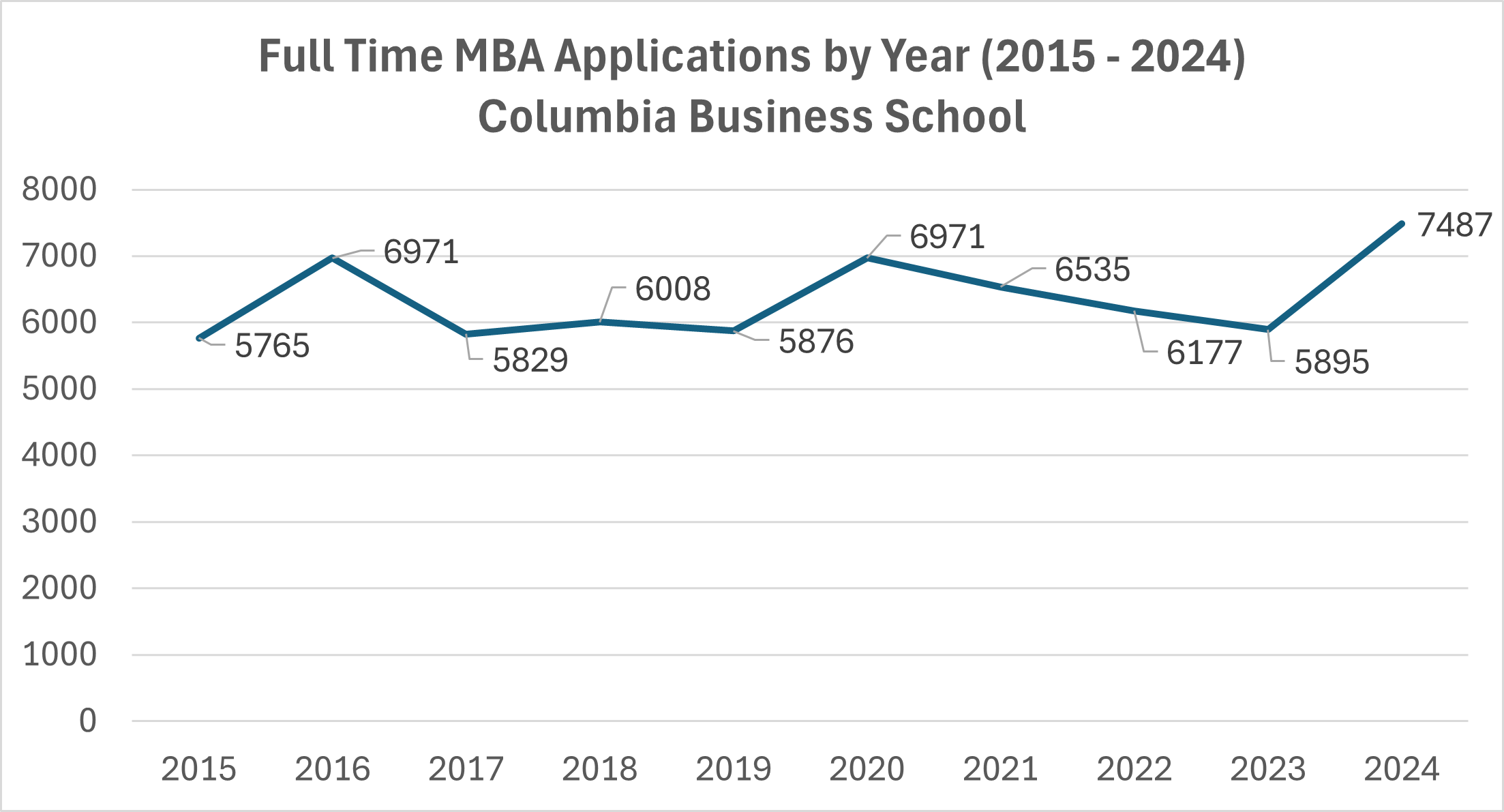
2024 was indeed the highest number of applications the school has seen in a decade. So far, so aligned with WSJ’s analysis.
Harvard Business School
Harvard Business School’s application numbers, however, show a different trend.
Harvard saw a 21% increase in application volume this year. 9,856 candidates applied for 2024 entry, compared to 8,149 for 2023 entry. As with Columbia, the HBS 2023 MBA application rates were the low point in a three-year decline that began with 9,773 in 2021 and dropped to 8,264 in 2022.
However, that 2021 figure of 9,773 was actually an increase on the previous year’s application numbers, which were 9,304 in 2020. And a look back at Harvard’s application numbers pre-pandemic tells quite a different story to CBS.
- 2019: 9,228
- 2018: 9,886
- 2017: 10,351
- 2016: 9,759
- 2015: 9,686
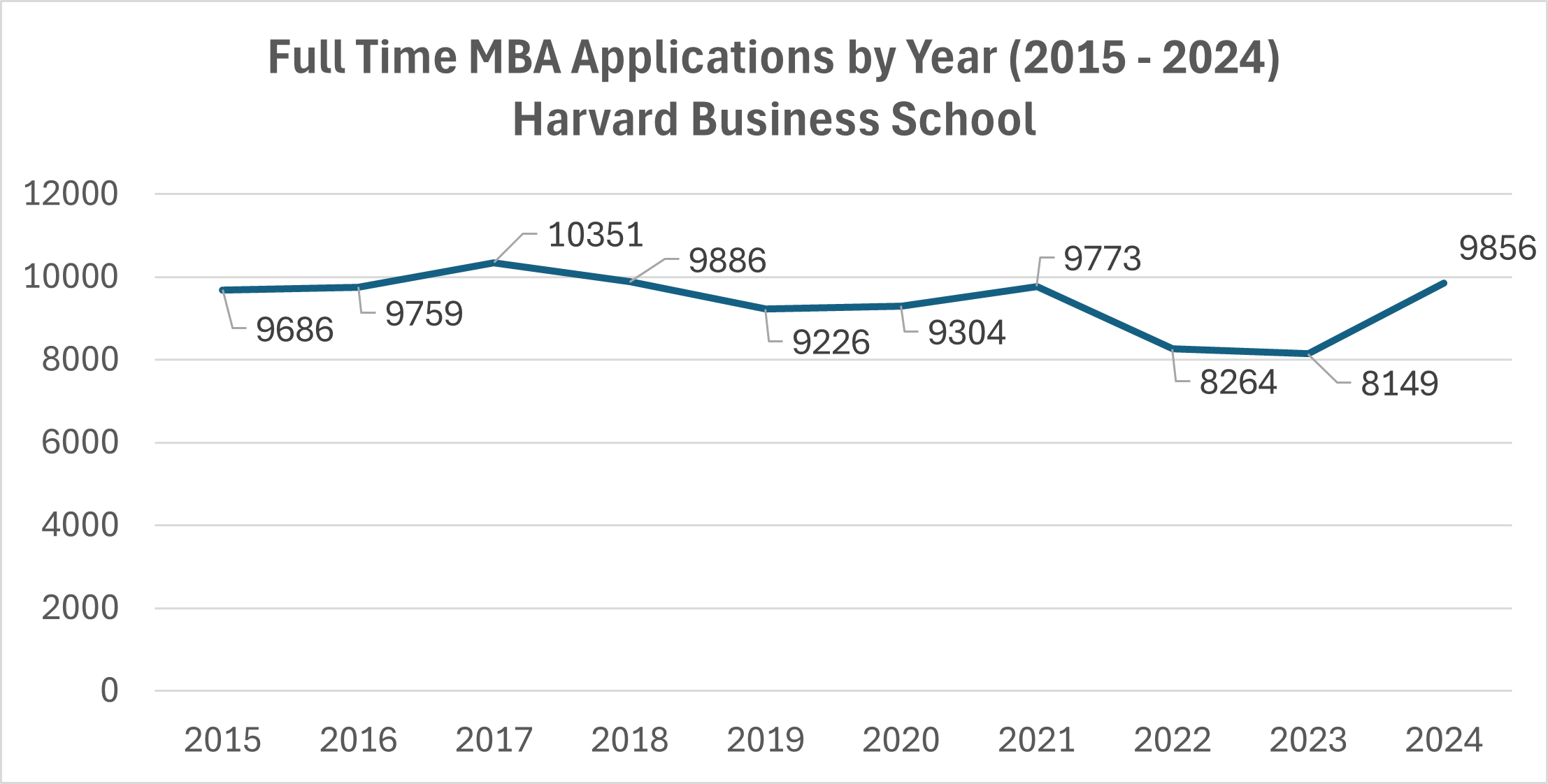
While CBS had never hit applicant numbers of 7000 before this year, Harvard’s 2024 statistic of 9,856 is no record. In fact, this number is pretty common for the school. Harvard’s applicant numbers have hovered between 9000 and 10000 for almost every year of the last 10, with 2022 and 2023 being the rare exceptions.
Chicago Booth School of Business
Chicago Booth saw another rise in applicants between 2023 and 2024: 22%. This year the school received 5,125 applications, compared to 4,184 last year.
Just like HBS, Chicago Booth’s decline in MBA application rates appears to be limited only to 2022 and 2023, in which 4,352 and 4,184 applications were received, respectively. Applications in the previous two years were both record highs, with Chicago Booth reporting 4,909 applications in 2020 and 5,037 in 2021.
And in the years leading up to the pandemic, applications looked something like this:
- 2019: 4,433
- 2018: 4,289
- 2017: 4,674
- 2016: 4,160
- 2015: data not available
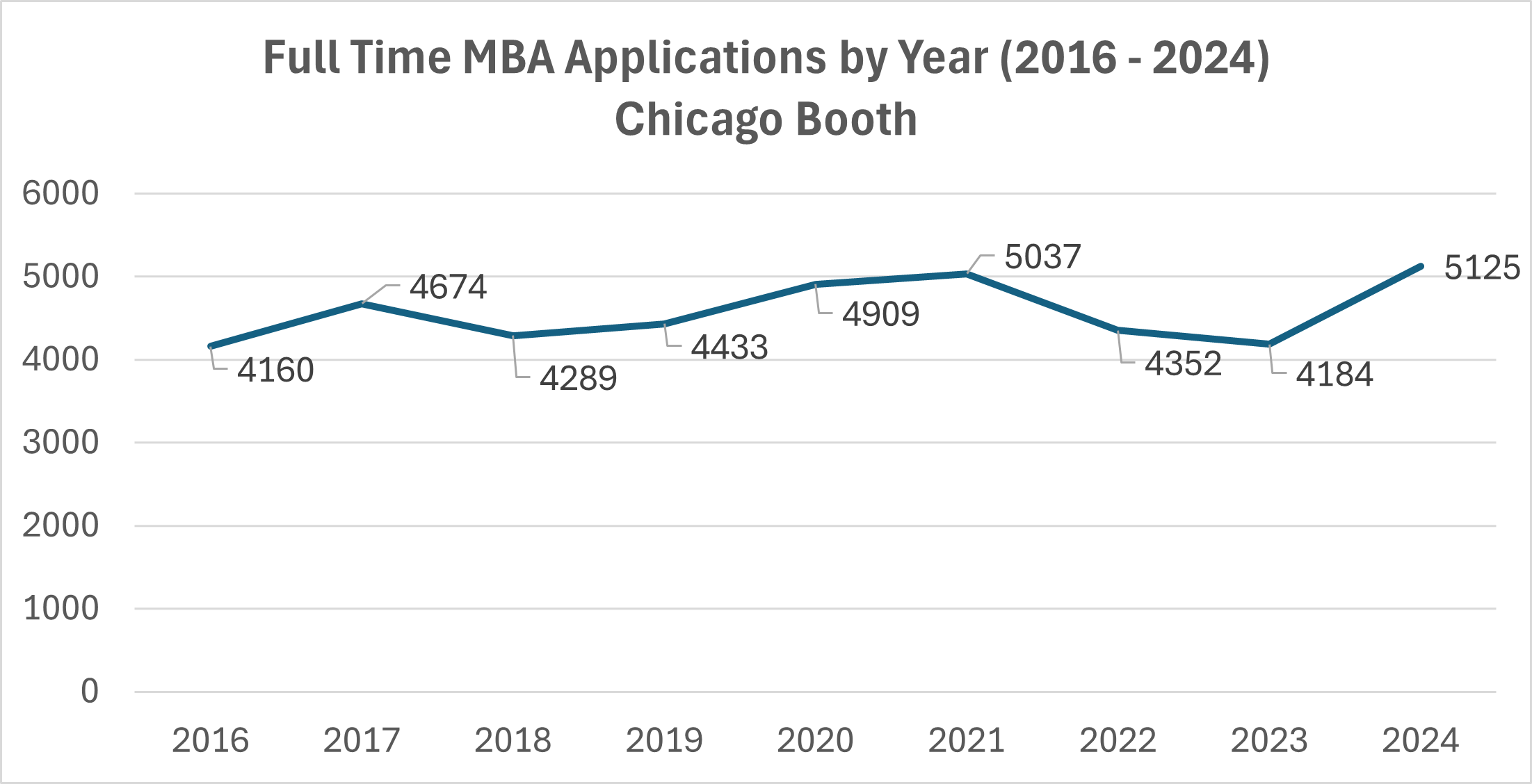
Against the backdrop of this data, the 2024 application figures for Chicago Booth don’t seem quite so extraordinary. Rather, they reflect and continue the steady climb in application numbers over the past ten years.
Stanford GSB
Stanford GSB, who received 7295 applications in 2024 compared to 6,190 in 2023, is essentially just returning to their 2019 application rate of 7,342. In addition, this is below the 8173 applications that Stanford GSB received in 2017.
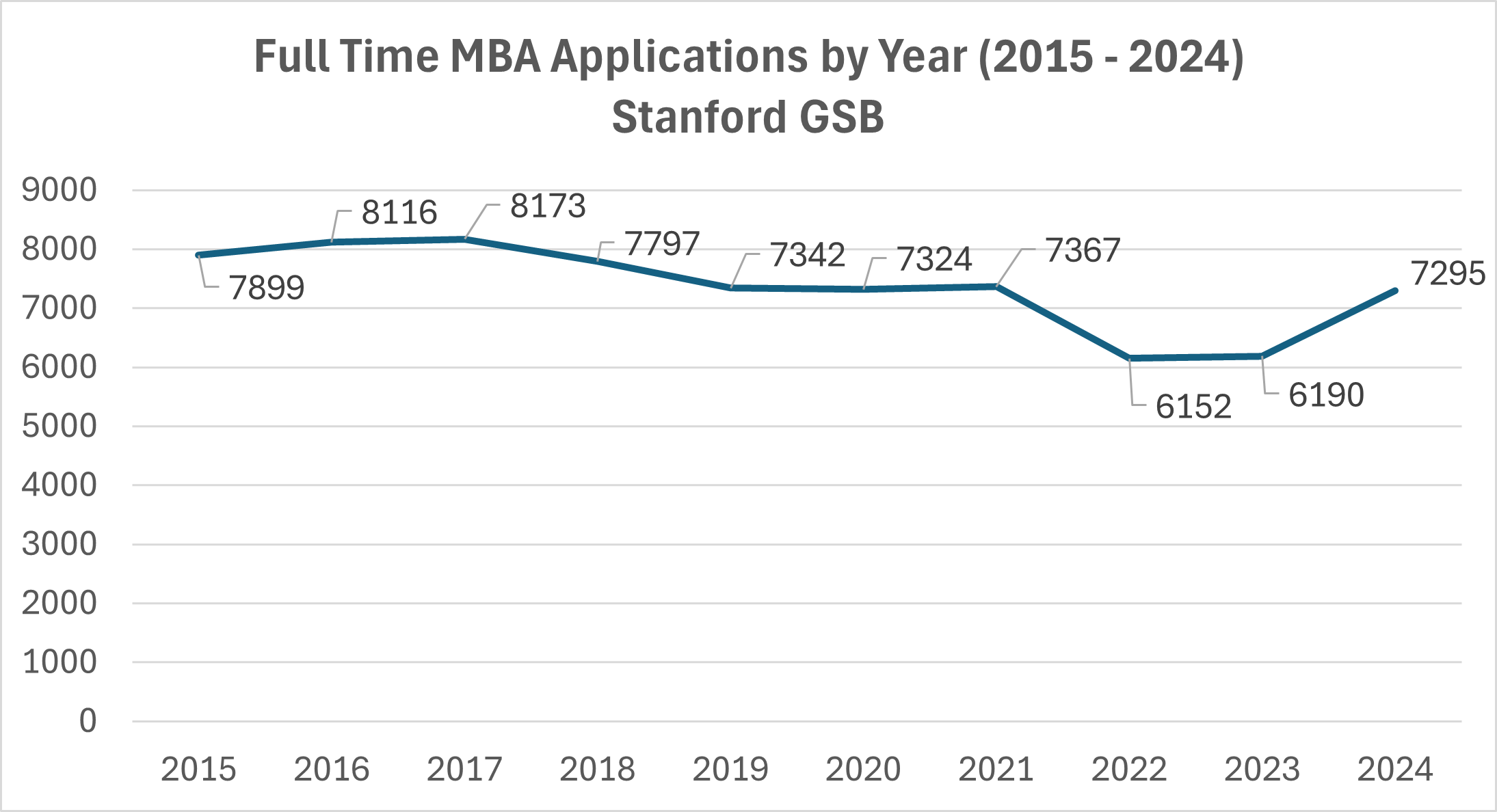
Yale SOM
Similarly, Yale SOM (for whom application numbers have swung between roughly 3100 and 4100 for the last eight years) reported 3738 applications this year, close to the application tallies in 2018 and 2021.
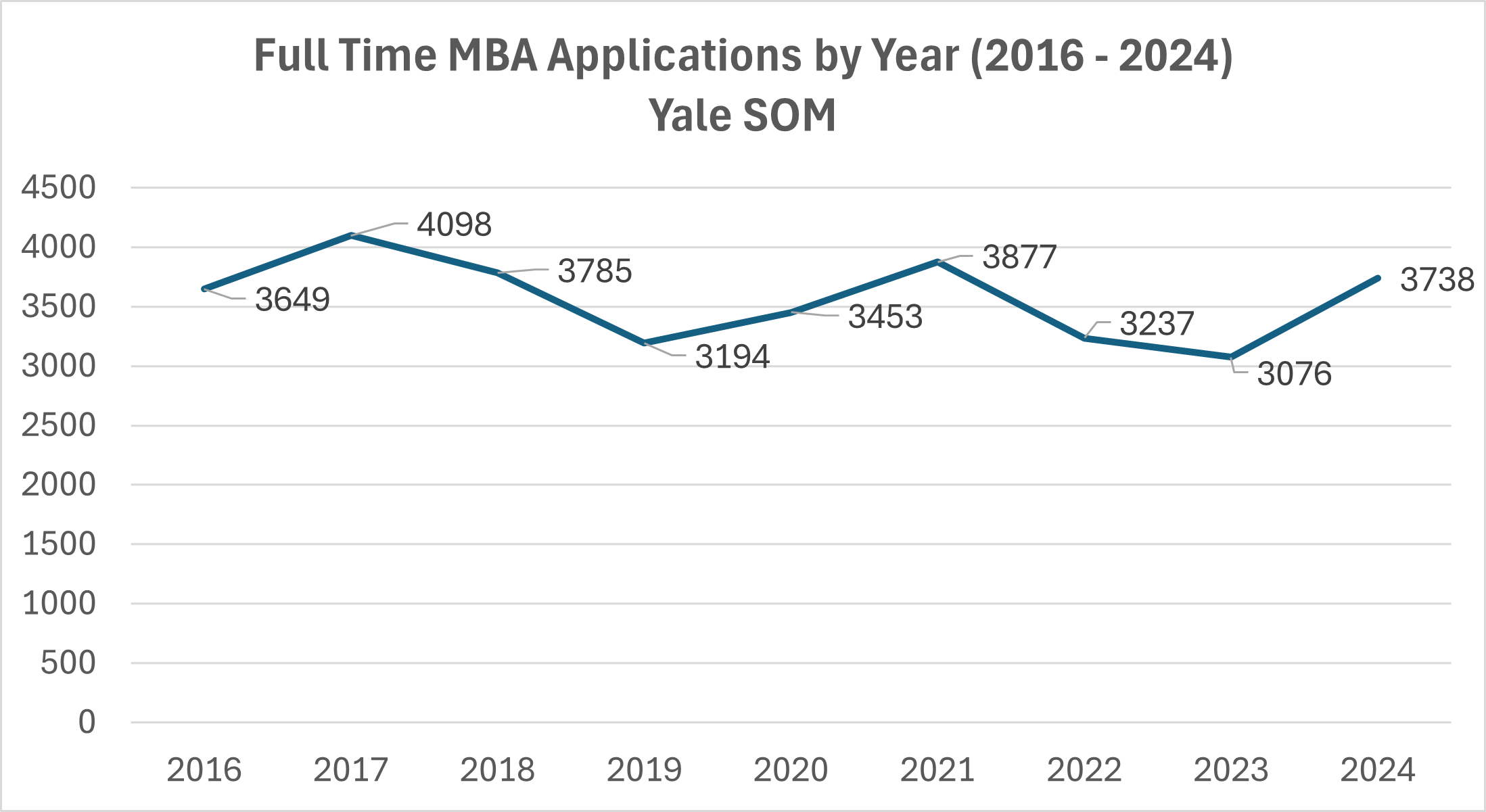
Wharton
Wharton’s application numbers fluctuate much more regularly and recurrently. This year’s application total 7,322 is similar to the tallies in 2020 and 2021, whereas the 6,194 and 6,319 applicants seen in 2023 and 2022 are more akin to numbers in 2017 and 2018.
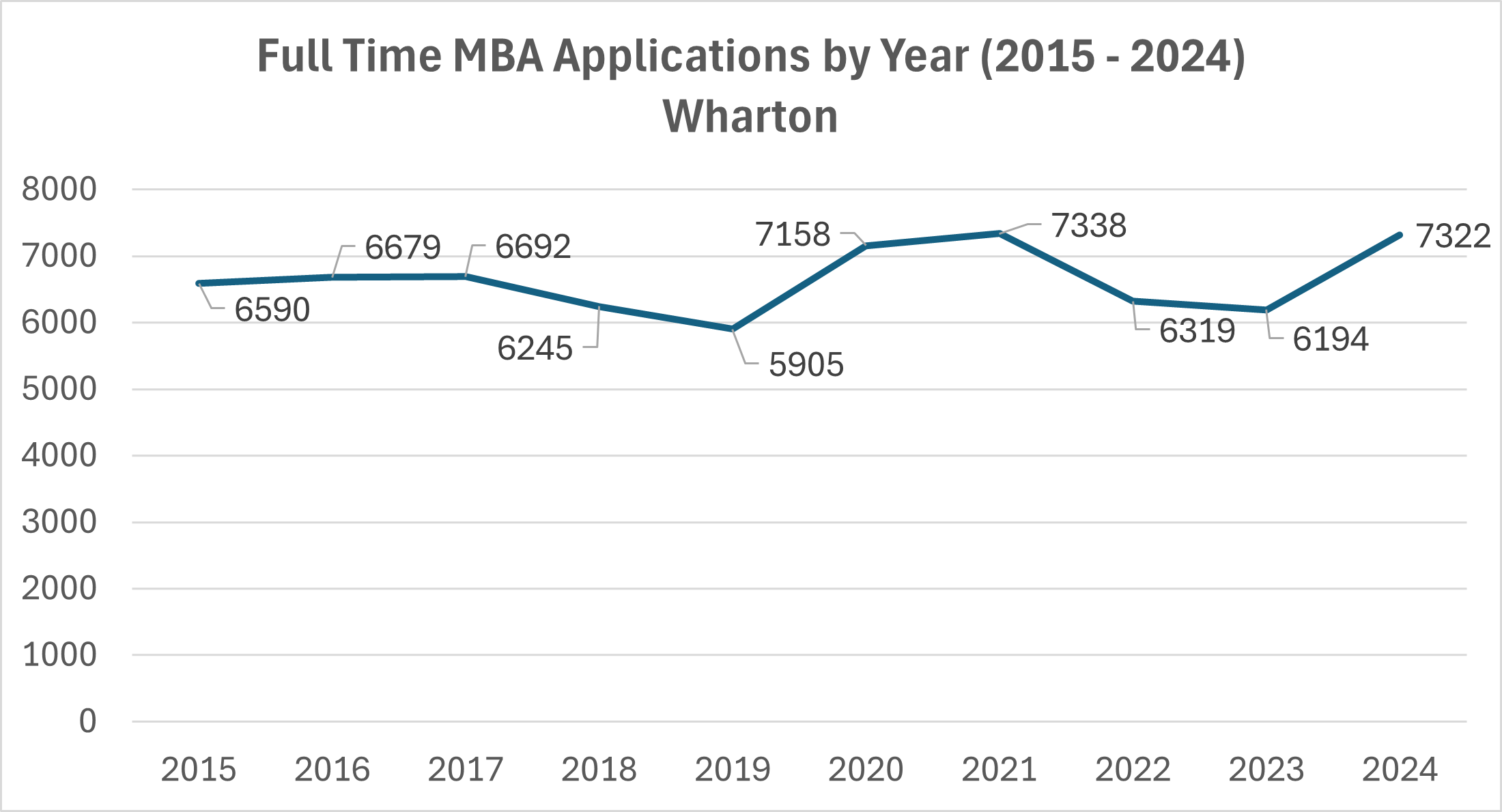
What Can We Conclude From These Application Numbers?
In 2022 and 2023 most schools experienced a decline in application volume that was, perhaps, caused by the abundance of tech and consultancy jobs in 2022, which drove people to choose work over study. The 2024 high application rates mark a return to the MBA’s pandemic application volume in 2020 and 2021 as well as in 2017.
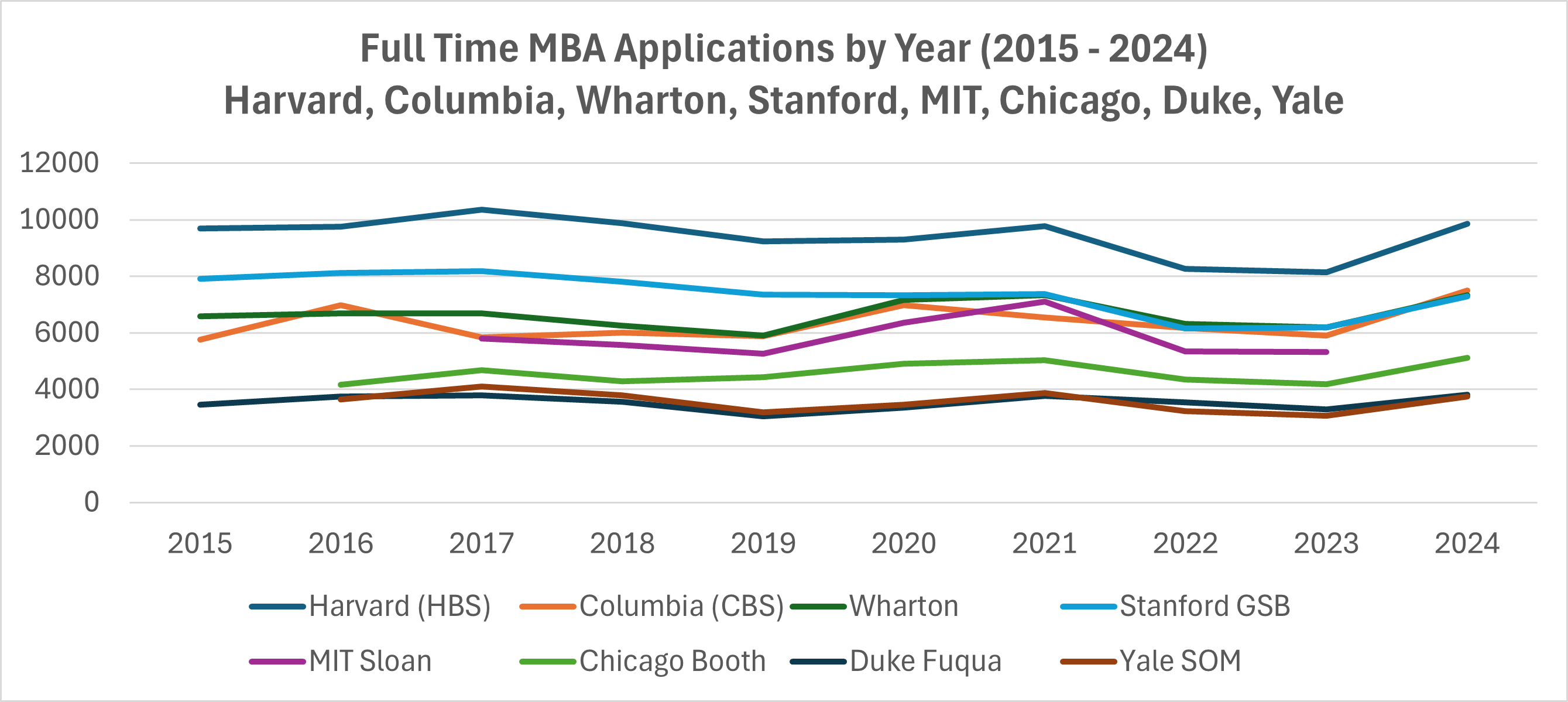
This trend of 2024 application numbers matching those seen several years ago can be seen across a range of leading MBA programs. Thus, rather than a total shake-up of the MBA trajectory, 2024’s high numbers seem to mark a return to previous high points in 2017, 2020 and 2021.
| School | 2024 | 2023 | 2022 | 2021 | 2020 | 2019 | 2018 | 2017 | 2016 | 2015 | 2014 |
| Chicago Booth | 5,125 | 4,184 | 4,352 | 5,037 | 4,909 | 4,433 | 4,289 | 4,674 | 4,160 | ||
| Columbia | 7,487 | 5,895 | 6,177 | 6,535 | 6,971 | 5,876 | 6,008 | 5,829 | 6,971 | 5,765 | 5829 |
| Duke Fuqua | 3,808 | 3,292 | 3,539 | 3,762 | 3,356 | 3,036 | 3,557 | 3,796 | 3,737 | 3,454 | |
| Harvard | 9,856 | 8,149 | 8,264 | 9,773 | 9,304 | 9,228 | 9,886 | 10,351 | 9,759 | 9,686 | 9543 |
| MIT Sloan | Not announced | 5,317 | 5,349 | 7,112 | 6,350 | 5,260 | 5,560 | 5,798 | |||
| Stanford GSB | 7,295 | 6,190 | 6,152 | 7,367 | 7,324 | 7,342 | 7,797 | 8,173 | 8,116 | 7,899 | 7355 |
| Wharton | 7,322 | 6,194 | 6,319 | 7,338 | 7,158 | 5,905 | 6,245 | 6,692 | 6,679 | 6,590 | 6111 |
| Yale SOM | 3,738 | 3,076 | 3,237 | 3,877 | 3,453 | 3,194 | 3,785 | 4,098 | 3,649 |
“-” indicates missing data ; could not find these figures online
So what caused the return to normality in 2024? There is the possibility that the job market is to blame, but GMAC thinks this might miss the full picture. “I would give much credit,” their CEO Joy Jones said, “to global business schools and their tremendous efforts to continue innovating with new technologies, new delivery tactics, and new ways of operating that satisfy the latest interests and needs of students and their future employers. Amongst these “new ways of operating” is the increased financial aid on offer in 2024, a step towards tackling the price of an MBA, so frequently cited as a “key barrier” to entry.
The Effect on Candidates
Regardless of whether or not this year’s high application number is a new phenomenon or part of an older trend, it has implications for candidates. A particularly pertinent one is the effect that high applications have on acceptance rates; as application volume goes up, class sizes often remain stable (or in Harvard’s case, even decrease), meaning that acceptance rates must come down. And as acceptance rates go down, competition goes up, resulting in particularly strong class profiles and climbing GMAT averages. You can read more about the Classes of 2026 (entering in 2024)—including application statistics and class profiles—on our school profile dashboard.






